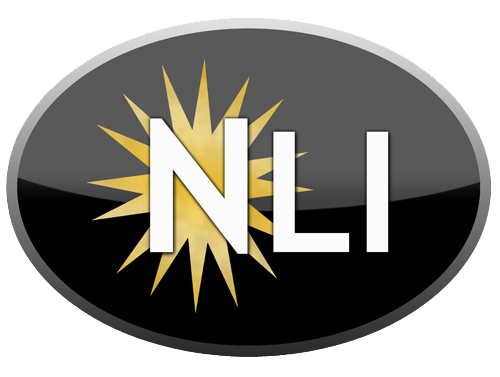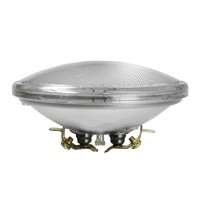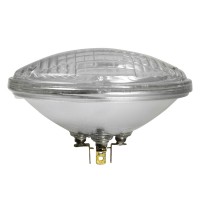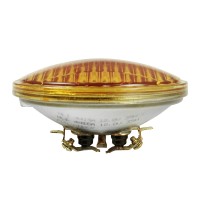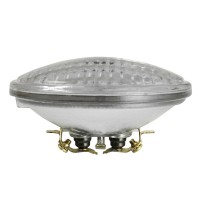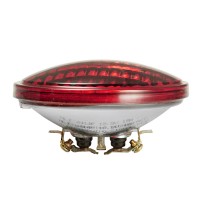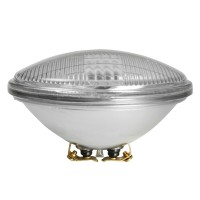Standard Sealed Beam
Standard sealed beam lamps represent the original sealed beam technology that dominated automotive and equipment lighting for over half a century, from the 1940s through the 1980s and continuing today in numerous applications where their simplicity, durability, and low cost make them practical choices. These traditional incandescent sealed beam headlights combine the tungsten filament light source, parabolic reflector, and glass lens into a single hermetically sealed unit designed as a complete replacement assembly rather than separate bulb-and-reflector components. While they've been largely superseded by halogen sealed beams and modern composite headlights in new vehicles, standard sealed beams remain relevant for maintaining classic and vintage vehicles in original condition, providing economical lighting for utility applications where maximum performance isn't required, and serving as OEM-specified replacement lamps for millions of tractors, industrial equipment, and older vehicles still in service worldwide.
The sealed beam concept revolutionized automotive lighting when introduced, solving the problems that plagued earlier separate-bulb-and-reflector headlights including burned-out filaments, corroded reflectors, moisture intrusion, misaligned bulbs, and inconsistent performance. By integrating everything into a sealed, weatherproof unit, sealed beam technology delivered reliable, predictable lighting performance that maintained the designed beam pattern and brightness throughout the lamp's life without adjustment or maintenance. The standardized sizes and electrical connections meant any standard sealed beam of the correct size would fit and perform as intended, eliminating compatibility concerns. This brilliant simplicity—install it and forget it until it burns out—made sealed beams the universal standard for decades and explains their continued use in applications prioritizing reliability and serviceability over ultimate performance.
Standard sealed beam construction uses conventional glass for the lens and reflector assembly, with the parabolic reflector typically silver-coated aluminum and the lens formed with prisms and patterns that shape the beam pattern. The tungsten filament operates in a vacuum or inert gas atmosphere (nitrogen or argon), producing warm white light at approximately 2,700-2,800K color temperature—the yellowish-white familiar from traditional incandescent lighting. The sealed construction prevents oxidation of the reflector and filament, maintaining performance until the filament eventually fails. Dual-filament sealed beams incorporate both high and low beam filaments in a single unit, switching between them via the vehicle's high-beam control. Single-filament versions serve as dedicated high beams or low beams in four-headlight systems. The robust glass construction withstands temperature extremes, vibration, moisture, and environmental exposure that would quickly destroy unsealed reflector systems.
Classic and vintage vehicle authenticity is a primary reason enthusiasts choose standard sealed beams over brighter halogen alternatives. For purists restoring and maintaining vehicles in original or period-correct condition, installing the same sealed beam technology the vehicle used when new preserves historical authenticity and proper appearance. Car shows, concours events, and judged competitions often scrutinize details including correct lighting equipment, making period-correct sealed beams important for serious restoration efforts. Even for drivers not pursuing concours-level authenticity, many prefer maintaining the original character of classic vehicles, including the warm light and particular performance characteristics of standard sealed beams that were integral to the driving experience of that era. For these owners, modern halogen brightness would feel incongruous with the vintage driving experience.
Agricultural and utility applications continue using standard sealed beams due to their low cost, adequate performance for non-highway use, and rugged reliability. Tractors, combines, and farm equipment operating primarily at low speeds on private property don't require the maximum visibility needed for highway driving, making economical standard sealed beams practical choices. Construction equipment, forklifts, warehouse vehicles, golf carts, and similar utility applications use standard sealed beams for basic lighting at minimal cost. Industrial facilities, parking lots, and outdoor area lighting sometimes use sealed beam fixtures with standard lamps for reliable, weatherproof illumination where premium performance isn't justified. For budget-conscious operations maintaining large fleets of older equipment, the cost difference between standard sealed beams ($8-15) and halogen versions ($20-35) multiplied across dozens or hundreds of lamps represents significant savings that may outweigh performance advantages in low-speed applications.
The light output of standard sealed beams, while modest by modern standards, was adequate for the highway speeds and traffic densities common when these lamps were standard equipment. Typical output ranges from 700-900 lumens depending on wattage and beam type, sufficient for 40-50 mph speeds on roads with reasonable lighting and low traffic. The warm 2,700K color temperature provides acceptable color rendering though with less contrast and object recognition than whiter halogen or HID lighting. For vintage vehicles driven occasionally, on low-speed roads, or primarily during daytime, standard sealed beam performance remains workable. Drivers accustomed to modern LED and HID headlights will find standard sealed beams noticeably dim, yellowish, and limiting for nighttime driving, making supplemental lighting or defensive driving practices advisable when operating vehicles with standard sealed beam headlights in contemporary traffic conditions.
Electrical specifications for standard sealed beams typically include 12-volt (most common in post-WWII vehicles), 6-volt (vintage vehicles through the 1950s), and occasionally 24-volt (military and some commercial vehicles). Wattages commonly range from 35-60 watts depending on size and beam type, with dual-filament beams using different wattages for low and high beam elements (e.g., 50W low beam / 60W high beam). The three-prong or two-prong electrical connector types standardized for decades ensure compatibility across brands and models. When replacing standard sealed beams, verify the voltage rating—installing 12V lamps in 6V systems or vice versa results in either dangerously bright, short-lived operation or dim, ineffective lighting. The wattage rating should match or closely approximate the original specification to ensure proper brightness and avoid overloading the vehicle's electrical system.
Common sizes of standard sealed beams include several standardized configurations established by SAE (Society of Automotive Engineers) specifications. The 7-inch round sealed beam is perhaps the most iconic, used on countless vehicles from the 1940s-1970s including classic American cars and trucks. The 5.75-inch round (often called 5-3/4 inch) serves smaller applications and many motorcycles. The 4x6 inch rectangular sealed beams became popular in the 1970s-80s for more aerodynamic styling. Specialty sizes including PAR36 (4.5-inch), PAR46 (5.75-inch), and PAR56 (7-inch) with screw terminals or wire leads serve off-road equipment, aviation ground support, and industrial applications. When ordering replacement standard sealed beams, measure the existing lamp or consult vehicle documentation to ensure correct size selection—sizes are not interchangeable.
Installation and aiming of standard sealed beams follows straightforward procedures unchanged for decades. Remove the headlight trim ring or bezel (typically held by screws), remove the sealed beam retaining ring (often a spring-loaded ring or screws), disconnect the electrical connector, remove the old sealed beam, connect the new sealed beam, reinstall the retaining ring ensuring proper alignment with adjustment screws, and reinstall the trim ring. After installation, aim the headlights using the vehicle's adjustment screws (typically two screws per headlight—vertical and horizontal aim) to ensure proper beam height and direction. Proper aim is essential for safe lighting performance and legal compliance; poorly aimed headlights either fail to adequately illuminate the road or blind oncoming drivers. Many auto parts stores and service shops offer headlight aiming services, or you can aim headlights yourself using wall patterns and measurement procedures detailed in service manuals.
Lifespan and maintenance for standard sealed beams is minimal—install them and use them until they burn out. Typical service life ranges from 400-1,000+ hours depending on filament design, operating voltage, vibration exposure, and duty cycle. When a filament burns out, the entire sealed beam is replaced; there are no user-serviceable parts. Keep spare sealed beams for critical applications to minimize downtime. Periodically clean sealed beam lenses with glass cleaner to remove dirt, bugs, and oxidation that reduce light transmission. Verify that the headlight bucket and electrical connector remain corrosion-free and provide good electrical contact. On older vehicles, corroded headlight buckets sometimes fail to properly ground the sealed beam, causing dim or intermittent operation—cleaning ground connections and improving ground paths resolves these issues. Beyond these basics, sealed beams require essentially no maintenance until replacement.
Common Applications: Classic and vintage vehicle restoration and maintenance, agricultural tractors and farm equipment, utility vehicles and forklifts, older trucks and commercial vehicles, off-road equipment and golf carts, industrial and warehouse vehicles, budget-conscious fleet applications, anywhere original-specification sealed beams maintain authenticity or provide adequate performance
Key Advantages: Low cost compared to halogen and quartz alternatives, authentic period-correct lighting for vintage vehicles, proven reliability and durability, simple installation and replacement, weatherproof sealed construction, standardized sizes ensure broad compatibility
Common Sizes: 7-inch round, 5.75-inch round, 4x6 inch rectangular, PAR36, PAR46, PAR56. Available in 6V, 12V, and 24V configurations. Verify size and voltage before ordering.
4422
Voltage: 12.8V, Wattage: 35W, Type: PAR36 Sealed Beam, Base Type: Screw Terminal Base, Life Hours..
$19.95
4420
Voltage: 12.8V, Wattage: 30W, Type: PAR46 Sealed Beam, Base Type: 3 Lug Base, Life Hours: 300..
$19.95
4416
Voltage: 12.8V, Wattage: 30W, Type: PAR36 Sealed Beam, Base Type: Screw Terminal Base, Life Hours..
$7.50
4415A
Voltage: 12.8V, Wattage: 35W, Type: PAR36 Sealed Beam, Base Type: Screw Terminal Base, Life Hours..
$14.95
4415
Voltage: 12.8V, Wattage: 35W, Type: PAR36 Sealed Beam, Base Type: Screw Terminal Base, Life Hours..
$7.50
4414R
Voltage: 12.8V, Wattage: 18W, Type: PAR36 Sealed Beam, Base Type: Screw Terminal Base, Life Hours..
$16.95
4414A
Voltage: 12.8V, Wattage: 18W, Type: PAR36 Sealed Beam, Base Type: Screw Terminal Base, Life Hours..
$12.95
4414
Voltage: 12.8V, Wattage: 18W, Type: PAR36 Sealed Beam, Base Type: Screw Terminal Base, Life Hours..
$7.50
4412
Voltage: 12.8V, Wattage: 35W, Type: PAR46 Sealed Beam, Base Type: Screw Terminal Base, Life Hours..
$12.95
4406
Voltage: 12.8V, Wattage: 35W, Type: PAR36 Sealed Beam, Base Type: Screw Terminal Base, Beam Spread..
$12.95
4405
Voltage: 12.8V, Wattage: 30W, Type: PAR36 Sealed Beam, Base Type: Screw Terminal Base, Beam Spread..
$12.95
4350
Voltage: 36V, Wattage: 60W, Type: PAR36 Sealed Beam, Base Type: Slip-On Terminal Base, Life Hours..
$22.95
4340
Voltage: 48V, Wattage: 80W, Type: PAR36 Sealed Beam, Base Type: Slip-On Terminal Base, Life Hours..
$18.95
4044-1
Voltage: 12V, Wattage: 12W, Type: PAR36 Sealed Beam, Base Type: Screw Terminal Base, Life Hours..
$7.50
4042
Voltage: 6.4V, Wattage: 12W, Type: PAR36 Sealed Beam, Base Type: Screw Terminal Base, Life Hours..
$14.50
4020 Headlight Sealed Beam Lamp
Voltage: 6.4V, Wattage: 30W, Type: PAR46 Sealed Beam, Base Type: 3 Lug Base, Life Hours: 300..
$24.95
4014
Voltage: 6.4V, Wattage: 18W, Type: PAR36 Sealed Beam, Base Type: Screw Terminal Base, Life Hours..
$7.50
4000
Voltage: 12V, Wattage: 37.5W, Type: PAR46 Sealed Beam, Base Type: 3 Lug Base, Life Hours: 200..
$6.95
